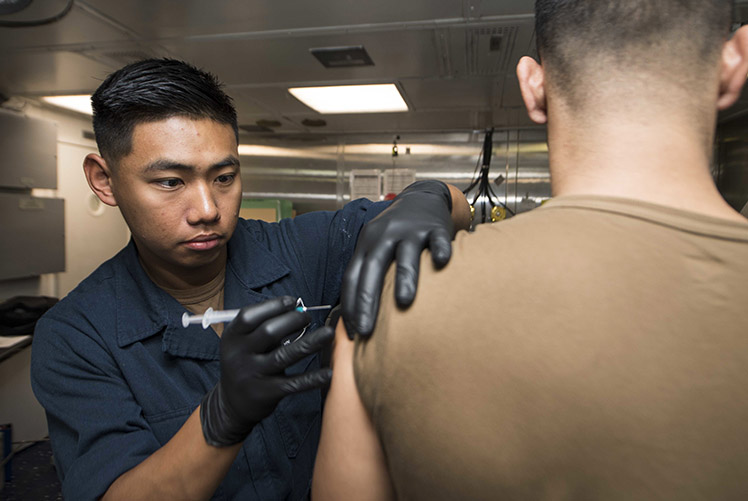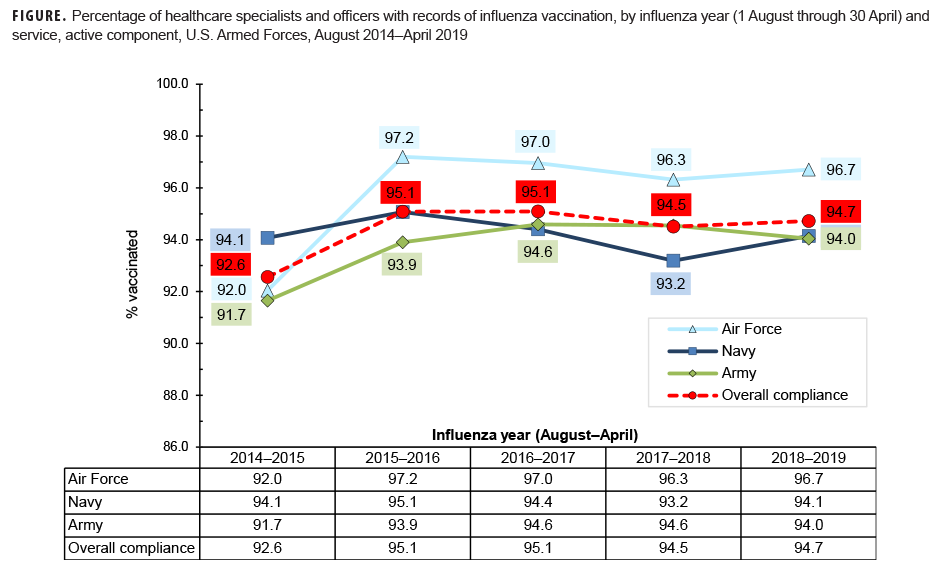Surveillance Snapshot: Influenza Immunization Among U.S. Armed Forces Healthcare Workers, Aug. 2014–April 2019
 181129-N-GR847-3000
ARABIAN GULF (Nov. 29, 2018) Hospitalman Jay Meadows, from Weaver, Ala., administers an influenza vaccine to a Sailor during a regularly scheduled deployment of the Essex Amphibious Ready Group (ARG) and 13th Marine Expeditionary Unit (MEU). The Essex ARG/13th MEU is flexible and persistent Navy-Marine Corps team deployed to the U.S. 5th Fleet area of operations in support of naval operations to ensure maritime stability and security in the Central Region, connecting to the Mediterranean and the Pacific through the western Indian Ocean and three strategic choke points. (U.S. Navy photo by Mass Communication Specialist 3rd Class Reymundo A. Villegas III)
181129-N-GR847-3000
ARABIAN GULF (Nov. 29, 2018) Hospitalman Jay Meadows, from Weaver, Ala., administers an influenza vaccine to a Sailor during a regularly scheduled deployment of the Essex Amphibious Ready Group (ARG) and 13th Marine Expeditionary Unit (MEU). The Essex ARG/13th MEU is flexible and persistent Navy-Marine Corps team deployed to the U.S. 5th Fleet area of operations in support of naval operations to ensure maritime stability and security in the Central Region, connecting to the Mediterranean and the Pacific through the western Indian Ocean and three strategic choke points. (U.S. Navy photo by Mass Communication Specialist 3rd Class Reymundo A. Villegas III)
The U.S. Advisory Committee on Immunization Practices recommends that all health care personnel be vaccinated against influenza to protect themselves and their patients.1 The Joint Commission's standard on infection control emphasizes that individuals who are infected with influenza virus are contagious to others before any signs or symptoms appear. The Joint Commission requires that health care organizations have influenza vaccination programs for practitioners and staff and that they work toward the goal of 90% receipt of influenza vaccine. Within the Department of Defense, seasonal influenza immunization is mandatory for all uniformed personnel and for health care personnel who provide direct patient care and is recommended for all others (excluding those who are medically exempt).2–4
This snapshot covers a 5-year surveillance period (Aug. 2014–April 2019) and presents the documented percentage compliance with the influenza immunization requirement among active component health care personnel of the Army, Navy, and Air Force. During the 2018–2019 influenza season, each of the 3 services had compliance rates of 94.0% or higher among health care personnel (Figure). For all services together, the compliance rate was 94.7%, very similar to the rate from the previous year.
References
- Centers for Disease Control and Prevention. Immunization of health-care personnel: recommendations of the Advisory Committee on Immunization Practices (ACIP). MMWR Recomm Rep. 2011;60(RR-7):1–45.
- Headquarters, Departments of the Army, the Navy, the Air Force, and the Coast Guard. Army Regulation 40-562, BUMEDINST 6230.15B, AFI 48-110_IP, CG COMDTINST M6230.4G. Medical Services: Immunizations and Chemoprophylaxis for the Prevention of Infectious Diseases. 7 Oct. 2013.
- Assistant Secretary of Defense for Health Affairs. Policy for Mandatory Seasonal Influenza Immunization for Civilian Health Care Personnel Who Provide Direct Patient Care in Department of Defense Military Treatment Facilities. Health Affairs Policy 08-005. 4 April 2008.
- Assistant Secretary of Defense for Health Affairs. Addition of Pandemic Influenza Vaccine or Novel Influenza Vaccine to the Policy for Mandatory Seasonal Influenza Immunization for Civilian Health Care Personnel Who Provide Direct Patient Care in Department of Defense Military Treatment Facilities. Health Affairs Policy 11-010. 28 July 2011.

You also may be interested in...
Article
Aug 1, 2022
The post-9/11 U.S. military conflicts in Iraq and Afghanistan lasted over a decade and yielded the most combat casualties since the Vietnam War. While patient survivability increased to the highest level in history, a changing epidemiology of combat injuries emerged whereby focus shifted to addressing an array of long-term sequelae, including ...
Article
Aug 1, 2022
During calendar year 2019, the estimated prevalence of myopia, hyperopia, and astigmatism were 17.5%, 2.1%, and 11.2% in the active component of the U.S. Armed Forces and 10.1%, 1.2%, and 6.1% of the U.S. Coast Guard, respectively.
Article
Jul 1, 2022
Respiratory pathogens, such as influenza and adenovirus, have been the main focus of the Department of Defense Global Respiratory Pathogen Surveillance Program (DoDGRPSP) since 1976.1. However, DoDGRPSP also began focusing on SARS-CoV-2 when COVID-19 was declared a pandemic illness in early March 2020.2. Following this declaration, the DOD quickly ...
Article
Jul 1, 2022
This report describes SARS-CoV-2 genomic surveillance conducted by the Department of Defense (DOD) Global Emerging Infections Surveillance Branch and the Next-Generation Sequencing and Bioinformatics Consortium (NGSBC) in response to the COVID-19 pandemic. Samples and sequence data were from SARS-CoV-2 infections occurring among Military Health System ...
Article
Jul 1, 2022
The Armed Forces Health Surveillance Division, as part of its surveillance mission, periodically conducts studies of cancer incidence among U.S. military service members. However, service members are likely lost to follow-up from the Department of Defense cancer registry and Military Health System data sets after leaving service and during periods of ...
Article
Jul 1, 2022
Lesbian, gay, and bisexual (LGB) individuals are at a particularly high risk for suicidal behavior in the general population of the United States. This study aims to determine if there are differences in the frequency of lifetime suicide ideation and suicide attempts between heterosexual, lesbian/gay, and bisexual service members in the active ...
Article
Jun 1, 2022
Surveillance snapshot: Illness and injury burdens, reserve component, U.S. Armed Forces, 2021
Article
Jun 1, 2022
As in previous years, among service members deployed during 2021, injury/poisoning, musculoskeletal diseases and signs/symptoms accounted for more than half of the total health care burden during deployment. Compared to garrison disease burden, deployed service members had relatively higher proportions of encounters for respiratory infections, skin ...
Article
Jun 1, 2022
The hospitalization rate in 2021 was 48.0 per 1,000 person-years (p-yrs), the second lowest rate of the most recent 10 years. For hospitalizations limited to military facilities, the rate in 2021 was the lowest for the entire period. As in prior years, the majority (71.2%) of hospitalizations were associated with diagnoses in the categories of mental ...
Article
Jun 1, 2022
In 2021, mental health disorders accounted for the largest proportions of the morbidity and health care burdens that affected the pediatric and younger adult beneficiary age groups. Among adults aged 45–64 and those aged 65 or older, musculoskeletal diseases accounted for the most morbidity and health care burdens. As in previous years, this report ...
Article
Jun 1, 2022
In 2021, as in prior years, the medical conditions associated with the most medical encounters, the largest number of affected service members, and the greatest number of hospital days were in the major categories of injuries, musculoskeletal disorders, and mental health disorders. Despite the pandemic, COVID-19 accounted for less than 2% of total ...
Article
Jun 1, 2022
The proportions of evacuations out of USCENTCOM that were due to battle injuries declined substantially in 2021. For USCENTCOM, evacuations for mental health disorders were the most common, followed by non-battle injury and poisoning, and signs, symptoms, and ill-defined conditions. For USAFRICOM, evacuations for non-battle injury and poisoning were ...
Article
Jun 1, 2022
In 2021, the overall numbers and rates of active component service member ambulatory care visits were the highest of any of the last 10 years. Most categories of illness and injury showed modest increases in numbers and rates. The proportions of ambulatory care visits that were accomplished via telehealth encounters fell to under 15% in 2021, compared ...
Article
Jun 1, 2022
Surveillance snapshot: Illness and injury burdens, recruit trainees, U.S. Armed Forces, 2021
Article
May 1, 2022
Tick-borne Encephalitis in Military Health System Beneficiaries, 2012–2021. Tick-borne encephalitis (TBE) is a viral infection of the central nervous system that is transmitted by the bite of infected ticks, mostly found in wooded habitats in parts of Europe and Asia
You are leaving Health.mil
The appearance of hyperlinks does not constitute endorsement by the Department of Defense of non-U.S. Government sites or the information, products, or services contained therein. Although the Defense Health Agency may or may not use these sites as additional distribution channels for Department of Defense information, it does not exercise editorial control over all of the information that you may find at these locations. Such links are provided consistent with the stated purpose of this website.
You are leaving Health.mil
View the external links disclaimer.
Last Updated: July 11, 2023